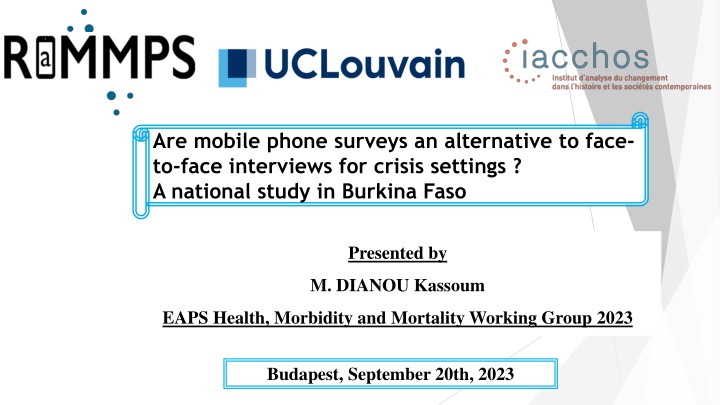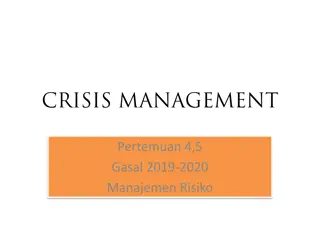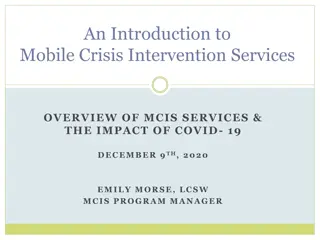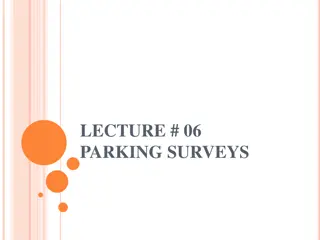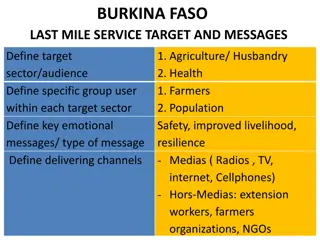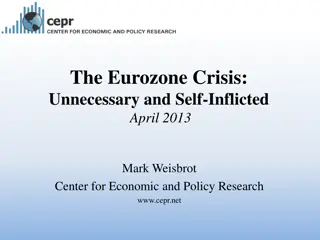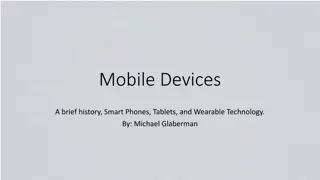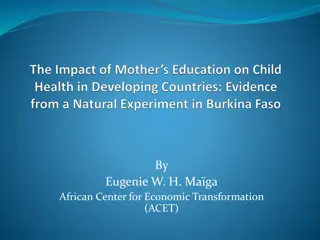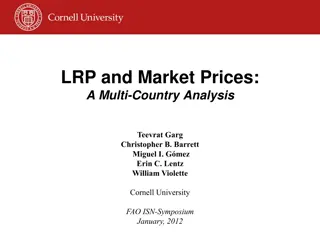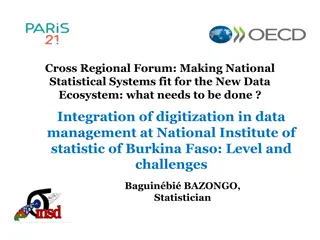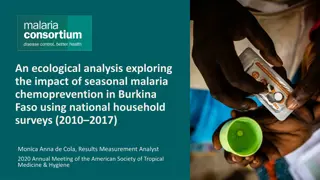Are Mobile Phone Surveys an Alternative to Face-to-Face Interviews in Crisis Settings? A National Study in Burkina Faso
Vital registration data source completeness remains low in many countries, prompting the exploration of alternative data collection methods like mobile phone surveys (MPS). MPS have advantages such as cost-effectiveness and quick deployment but face challenges like network quality. This study in Burkina Faso aims to compare mortality data from MPS with face-to-face surveys to assess their reliability, focusing on under-five mortality and adult and old-age mortality trends.
Download Presentation

Please find below an Image/Link to download the presentation.
The content on the website is provided AS IS for your information and personal use only. It may not be sold, licensed, or shared on other websites without obtaining consent from the author.If you encounter any issues during the download, it is possible that the publisher has removed the file from their server.
You are allowed to download the files provided on this website for personal or commercial use, subject to the condition that they are used lawfully. All files are the property of their respective owners.
The content on the website is provided AS IS for your information and personal use only. It may not be sold, licensed, or shared on other websites without obtaining consent from the author.
E N D
Presentation Transcript
Are mobile phone surveys an alternative to face- to-face interviews for crisis settings ? A national study in Burkina Faso Presented by M. DIANOU Kassoum EAPS Health, Morbidity and Mortality Working Group 2023 Budapest, September 20th, 2023
Context Vital registration is the ideal data source Completeness of death registration remains too low in most low- and middle-income countries (LMICs) face-to-face ; very infrequent, Updated information or data Mortality levels and trends in this region : retrospective surveys and censuses. The pandemic has since highlighted the limitations of face-to- face data collection Development of IT tools and the diversification of communication channels, few countries had explored alternative forms of data collection on mortality - event of a natural disaster Difficult to implement in other crisis settings: - conflict ; - insufficient resources in terms of time and resources Viable data collection methods for mortality estimation is needed Recent increase in cell phone network coverage and use.
What is known about MPS Mobile phone surveys (MPS) have several advantages (Chasukwa et al., 2022; Kuehne et al., 2016; Soullier et al., 2022). - sampling and non-sampling bias - less expensive - quicker to deploy - selection biases - lower response rates - network quality is problematic They are However - can be conducted at higher frequencies - allow flexibility in questionnaire design - ability of interviewers to establish a trusting relationship opinion surveys evaluating health interventions with specific populations tracking certain demographic events in Health and Demographic Surveillance Systems the impact of the Ebola or Covid-19 crises on household living conditions and assess prevention behaviors In Sub-Saharan Africa, there has been a proliferation of MPS in recent years. However, these are often small-scale surveys : Few MPS surveys focused explicitly on measuring excess mortality, however, with few notable exceptions
Objectives Collect data on : Survival of children, Siblings Parents. Few studies have compared the data quality and reliability of mortality indicators derived from face-to-face and MPS surveys. This research aims to compare mortality levels and trends from MPS with face-to-face surveys in Burkina Faso. We report on mortality levels and trends extracted from a survey conducted in the context of the RaMMPS project (Rapid Mortality Mobile Phone Surveys). We compare estimates with those obtained from the 2019-2020 census and the latest Demographic and Health Surveys (DHS) available in the country (from 2010), in addition to mortality estimates derived from the United Nations agencies. This comparison covers under-five mortality, captured in the MPS through birth histories, mortality in adults aged 15-49, measured through sibling survival histories, and old-age mortality (30q50), measured through a new survey module collecting parental survival histories.
Data and methods (1/2) Two sampling strategies were used: (1) Pre-collected phone number from a face-to-face survey called Harmonized Survey of Household Living Conditions (EHCVM for Enqu te harmonis e sur les conditions de vie des m nages) (2) Randomly drawing telephone numbers, commonly called Random Digit Dialing (RDD). Respondents receive a call credit incentive at the end of the interview. Information on : household composition, household deaths, survival of close relatives (children, siblings and parents) and COVID-19 vaccination
Data and methods (2/2) To measure under-five mortality, we used direct and indirect methods Truncated birth histories involve asking questions only about recent births (defined according to a reference period prior to the survey) or latest births (based on birth order), rather than a complete history of all past births. Thus, this information allows the use of direct methods Prior to this truncated history, we also collected the total number of children born alive and the total number of surviving children, by sex. These information's allows the use of indirect methods. To measure adult mortality, we used direct methods with Sibling survival histories (SSH) information. a shortened version of the sibling module used in Demographic and health Surveys was designed. We limited the information collected to the total number of living siblings born to the respondent s biological mother, the number of deceased siblings, and the number of siblings who had died since the beginning of 2019. For siblings who had died since 2019, additional details about the date, place, and circumstances of death were collected. To measure mortality among older adults (50q30), we used direct and indirect methods with parental survival histories (PSH) information's. Adults reported on the survival status of their mother and father, their current age or their age at death when deceased, and the number of years since their death.
Results (1/4) The composition of the RaMMPS samples vs 2019-2020 census RDD arm (population aged 15-64 years olds) Rural respondents in EHCVM and RDD samples, < Census represented 69 per cent EHCVM arm (heads of households) Census Census Unweight ed Weighted Unweighted Weighted Respondents characteristics % % 95% CI % % % 95% CI % Type of place of residence Population without any formal education was underrepresented by at least 20 percentage points in each study arm. Ouagadougou 11.1 13.0 [11.4-14.8] 14.4 15.8 11.5 [10.6-12.4] 14.5 Bobo-Dioulasso 6.1 3.4 [2.6-4.4] 5.0 6.7 3.8 [3.3-4.4] 5.2 Other towns 40.2 13.5 [12.0-15.3] 11.9 14.3 9.3 [8.5-10.2] 11.4 42.6 68.7 63.2 69.0 Rural areas 70.1 [67.7-72.3] 75.4 [74.1-76.6] The proportion of the population residing in small households, counting less than 9 members, was lower in our sample Education 52.0 72.2 44.9 69.8 None 69.5 [67.1-71.8] 67.6 [66.1-69.0] Primary 20.2 11.2 [9.7-12.9] 10.0 16.5 11.5 [10.5-12.5] 9.6 Secondary 21.4 13.7 [12.1-15.6] 13.5 29.5 15.7 [14.6-16.8] 15.9 Superior and higher 6.4 5.6 [4.5-6.9] 4.2 9.0 5.2 [4.6-5.9] 3.6 Cell phone owners in the 2021-2022 is found to be younger, better educated, more urban, and in households that are better equipped in terms of electricity, roof type, or water access. Household size 49.4 49.4 1-4 members 21.5 32.9 [30.5-35.3] 28.5 39.2 [37.6-40.7] 36.5 36.5 5-8 members 43.0 37.4 [34.9-39.9] 41.9 33.7 [32.3-35.3] 9+ 35.4 29.7 [27.4-32.1] 14.1 29.6 27.1 [25.7-28.6] 14.1 The phone call outcome rates by study arm, shows : higher response rates, higher cooperation rates and higher contact rates in the EHCVM study arm, in which the respondents had previously been interviewed face-to-face, compared to the RDD approach
Results (2/4) All three data sources show the expected rise in parity with age, but at different levels. Mean numbers of children ever born are lower in the RaMMPS survey than in the 2010 DHS, as expected, since fertility has declined slightly since 2010. By contrast, the estimates from the latest census are quite lower than those based on the surveys. The UN IGME estimates depict a downward trend in mortality over the entire period, and this is reflected in indirect estimates from RaMMPS. While there are differences between the RaMMPS indirect and UN IGME estimates, these differences are not significant Direct estimates extracted from truncated birth histories collected in the RaMMPS survey are quite lower than those from the UN IGME, but are in line with those of the DHS 2021
Results (3/4) We observe only small differences between the two study arms and the DHS survey. Age group <20 yrs 20-24 yrs 25-29 yrs 30-34 yrs 35-39 yrs 40-44 yrs 45-49 yrs Total EHCVM 6.0 5.8 6.1 6.3 6.7 7.0 6.9 6.4 RDD 5.8 5.8 6.1 6.4 6.5 6.5 6.6 6.2 Both arms combined 5.9 5.8 6.1 6.4 6.6 6.8 6.7 6.3 DHS 6.5 6.7 6.9 6.8 6.8 6.6 6.4 6.7 Respondents in the DHS tended to report a slightly higher number of siblings up to the 35-39 age group, while the reverse is true for older respondents. However, these differences are quite small (less than 0.5 siblings on average), which is remarkable considering the differences in the instruments used. The WPP estimates have tended to be above the estimates derived from sibling survival data in DHS conducted in 1998-1999, 2003 and 2010 the direct estimates obtained with limited imputation, based on all available data in the RaMMPS survey are conspicuously and implausibly low Estimates based on the imputed ages and dates are much higher and in line with previous DHS surveys
Results (4/4) Expected downward trend in the proportion of parents still alive according to the age group of the respondents with a faster decline for fathers Censuses and surveys are known to be affected by the adoption bias, introducing upward bias in the proportions of parents surviving Both the direct and indirect estimates from RaMMPS are lower than the rates from the United Nations. Indirect estimates from RaMMPS are much higher than those extracted from the 2019 census. However, it should be noted that the mortality levels of the elderly are very uncertain in Burkina Faso.
Discussion Trends in under-five mortality derived from the MPS are relatively consistent with other estimates from face-to- face surveys and censuses. Truncated birth histories could be plagued by misreporting errors such as transfers of some children (living or dead) beyond the reference period (Tabutin & Masquelier, 2017; You et al., 2015). Regarding adult mortality, our study suggests that the MPS tends to underestimate the level of mortality when based on summary sibling data. Summary sibling histories are subject to greater error than full sibling survival histories. Transfer of sibling deaths prior to the reference period (2019-2022). Data quality assessment (EHCVM arm and RDD arm). MPS survey produced old-age mortality estimates close to those of the World Population Prospects for fathers, when estimated indirectly. In this age group, we are lacking a robust reference to compare our estimates
Conclusion In summary, the mobile phone survey has proven to be a feasible and acceptable alternative method when face-to-face data collection is not possible. However, this method has some important limitations with implications for mortality estimation. absence of additional information on the socio-demographic characteristics of the customers the place from which respondents participate in the interview the telephone survey involves the use of fairly short questionnaires response rates were much lower than predicted Despite these limitations, the results of our analyzes of mortality levels and trends show that it is possible to carry out a large-scale national survey in Burkina Faso, and in sub-Saharan Africa, from a sample of numbers randomly generated mobile phone numbers, or from pre-registered numbers during a face-to-face survey, to collect information on mortality. - quota sampling strategy - recommend the use of full birth and full sibling histories rather than shortened instruments. In future mobile phone surveys - a good communication strategy to inform the population
Are mobile phone surveys an alternative to face- to-face interviews for crisis settings ? A national study in Burkina Faso Presented by M. DIANOU Kassoum EAPS Health, Morbidity and Mortality Working Group 2023 Budapest, September 20th, 2023
